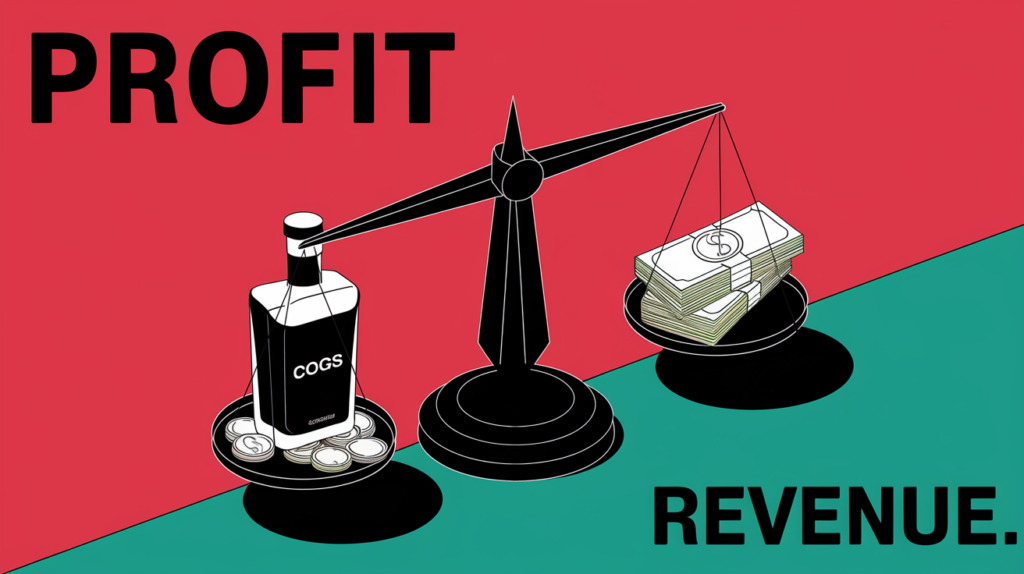Running a successful bar or restaurant isn’t just about serving great drinks—it’s also about keeping a close eye on your expenses to ensure profitability. Understanding how to calculate your liquor cost is a fundamental part of managing your business effectively. In this guide, we’ll explore how to calculate and manage your liquor costs so you can make informed decisions about your beverage offerings and improve your bottom line.
Key Points to Remember
- Boosting Profits: Knowing your liquor cost helps you understand where your money is going, allowing you to optimize pricing and make smarter purchasing choices.
- What Affects Liquor Cost: Various elements like rent, food expenses, staff wages, waste, pour sizes, and food sales can influence your liquor cost.
- Controlling Costs: You can reduce your liquor cost percentage through strategies like careful inventory management, preventing theft, reducing waste, standardizing recipes, and adjusting prices thoughtfully.
Understanding Liquor Cost Percentage
The liquor cost percentage represents the portion of your alcohol sales that goes toward purchasing the alcohol itself. It’s calculated by comparing the cost of the alcohol you’ve sold (your cost of goods sold, or COGS) to the revenue you’ve made from alcohol sales. A higher percentage means you’re spending more on liquor relative to what you’re earning, which can cut into your profits.
The Formula:
Liquor Cost Percentage = (Cost of Alcohol Sold / Alcohol Sales Revenue) x 100An Example:
Suppose you spent $1,500 on alcohol that you sold, and you made $5,000 from selling drinks. Your liquor cost percentage would be:
Liquor Cost Percentage = ($1,500 / $5,000) x 100 = 30%This means 30% of your alcohol sales revenue goes toward the cost of the alcohol itself.
Why Beverage Cost Matters for Your Profit
Every dollar you save on liquor costs is a dollar added to your profit. By keeping track of your liquor cost percentage, you can identify areas where you might be overspending. This awareness allows you to take steps to reduce costs, such as negotiating better prices with suppliers, minimizing waste, or adjusting your pricing strategy.
Step-by-Step Guide to Calculating Liquor Cost
Calculating your liquor cost isn’t complicated, but it does require accurate records. Here’s how you can do it:
1. Calculate Your Cost of Alcohol Sold:
To find out how much you spent on the alcohol you’ve sold, you’ll need to:
- Find Your Beginning Inventory Value: Determine the total value of the alcohol you had in stock at the start of the period.
- Add Purchases: Add the cost of any additional alcohol you’ve purchased during the period.
- Subtract Ending Inventory Value: Subtract the total value of the alcohol remaining at the end of the period.
The Calculation:
Cost of Alcohol Sold = Beginning Inventory + Purchases - Ending InventoryAn Example:
- Beginning Inventory: $5,000 worth of alcohol in stock at the start.
- Purchases: $2,000 spent on new alcohol during the period.
- Ending Inventory: $5,500 worth of alcohol left at the end.
Cost of Alcohol Sold = $5,000 + $2,000 - $5,500 = $1,500This means you sold $1,500 worth of alcohol during the period.
2. Calculate Your Liquor Cost Percentage:
Now that you have your Cost of Alcohol Sold and your Alcohol Sales Revenue, plug them into the formula:
Liquor Cost Percentage = ($1,500 / $5,000) x 100 = 30%Don’t Forget Unsold Products in Your Inventory
It’s important to account for any unsold inventory, including losses from spoilage, breakage, or theft. These losses can affect your ending inventory value and, consequently, your cost calculations. By keeping accurate records of these incidents, you can ensure your liquor cost percentage reflects the reality of your business.
What Is a Good Liquor Cost Percentage?
In the bar and restaurant industry, a typical liquor cost percentage ranges from 18% to 24%. This means that for every dollar you earn from alcohol sales, about 18 to 24 cents go toward the cost of the alcohol. Knowing this benchmark can help you evaluate your own performance and set appropriate pricing.
Practical Ways to Lower Your Liquor Cost Percentage
Reducing your liquor cost doesn’t necessarily mean cutting corners. Here are some effective strategies:
Picture a bartender using precise measuring tools to pour the perfect drink.
1. Regularly Track Your Inventory
- Spot Discrepancies: Identify inconsistencies that might indicate theft or waste.
- Manage Stock Levels: Ensure you’re not overstocking or running low on popular items.
- Make Informed Decisions: Adjust your purchasing and pricing strategies based on actual data.
2. Implement Security Measures to Prevent Theft
- Use Inventory Software: Track stock levels in real-time.
- Secure High-Value Items: Keep expensive bottles in locked storage.
- Monitor Access: Limit who has access to storage areas.
3. Reduce Waste Through Training and Tools
- Train Your Staff: Educate bartenders on proper pouring techniques.
- Use Measuring Tools: Provide jiggers, pour spouts, or automated systems.
- Standardize Recipes: Ensure every drink is made consistently.
4. Optimize Your Menu
- Highlighting High-Margin Drinks: Promote beverages that are profitable.
- Streamlining Offerings: Remove slow-selling or low-margin items.
- Introducing Specials: Rotate specials to keep the menu fresh and exciting.
5. Negotiate with Suppliers
- Seek Volume Discounts: Purchase in bulk for popular items.
- Compare Prices: Regularly check if you’re getting the best rates.
- Explore Alternative Brands: Find quality options at lower prices.
Factors That Influence Your Liquor Costs
Being aware of what affects your liquor cost can help you manage it more effectively:
Pour Sizes and Consistency
| Pour Type | Volume (ounces) |
|---|---|
| Standard Shot | 1.5 |
| Pony Shot | 1 |
| Double | 3 |
| Wine Pour | 5 |
| Beer Pint | 16 |
Make sure all staff are trained to pour accurately.
Product Mix and Variety
- Focusing on Popular Items: Stock what sells the most.
- Limiting Similar Products: Reduce overlap in your offerings.
- Testing New Items Carefully: Introduce new drinks on a trial basis.
Inventory Shrinkage
- Keep Detailed Records: Document all incidents meticulously.
- Use Surveillance Cameras: Monitor storage and service areas.
- Implement Policies: Have clear procedures for handling and reporting issues.
Happy Hour and Promotions
- Feature High-Margin Items: Promote drinks that cost less to make.
- Set Time Limits: Keep happy hours short and during off-peak times.
- Encourage Upselling: Train staff to suggest premium options.
Food Sales Impact
- Increase Overall Revenue: Customers may stay longer and spend more.
- Attract Different Audiences: Broaden your customer base.
- Allow for Combos: Offer meal and drink packages.
Using Technology to Your Advantage
- Inventory Management Software: Automates tracking, provides real-time data, and generates reports.
- Point of Sale (POS) Systems: Integrate sales data with inventory levels, helping you monitor performance instantly.
- Analytics Tools: Offer valuable insights such as:
- Best-Selling Drinks: Identify which beverages are most popular to focus your marketing efforts.
- Peak Hours: Determine the busiest times to schedule staff accordingly.
- Customer Preferences: Analyze buying patterns to tailor your menu.
- Sales Trends: Spot seasonal fluctuations to adjust inventory and promotions.
- Staff Performance: Evaluate who sells the most and who might need additional training.
By leveraging these insights, you can make data-driven decisions that enhance profitability.
Tips from Experienced Bar Owners
- Prioritize Staff Training: Well-trained staff can reduce waste, improve customer service, and increase sales.
- Engage with Customers: Understanding what your customers like can help you tailor your offerings.
- Monitor Industry Trends: Stay updated on popular drinks, emerging brands, and consumer preferences.
Common Mistakes to Avoid
Avoid these pitfalls to keep your liquor cost under control:
- Ignoring Inventory Discrepancies: Small inconsistencies can indicate larger issues.
- Overcomplicating the Menu: Too many options can overwhelm customers and increase costs.
- Neglecting Regular Cost Calculations: Frequent monitoring allows for timely adjustments.
Final Thoughts
Managing liquor costs is a continuous effort that requires attention to detail and proactive strategies. By regularly calculating your liquor cost percentage and understanding the factors that affect it, you can make informed decisions that enhance your profitability. Remember, the goal isn’t just to cut costs but to optimize your operations for long-term success.
By taking these steps and staying engaged with every aspect of your beverage program, you’re setting your business up for success. Cheers to smarter management and better profits!
FAQs
What if I don’t have time to track my inventory?
Consider using inventory management software to automate the process and save time.
How often should I calculate my liquor cost percentage?
Ideally, calculate it weekly or monthly to stay on top of your costs and make timely adjustments.
What resources are available to help me learn more about bar management?
Many online resources, books, and industry associations offer valuable information and training.
Need help managing your bar’s finances?
Contact XOA TAX for expert assistance
- Website: https://www.xoatax.com/
- Phone: +1 (714) 594-6986
- Email: [email protected]
- Contact Page: https://www.xoatax.com/contact-us/




 anywhere
anywhere  anytime
anytime